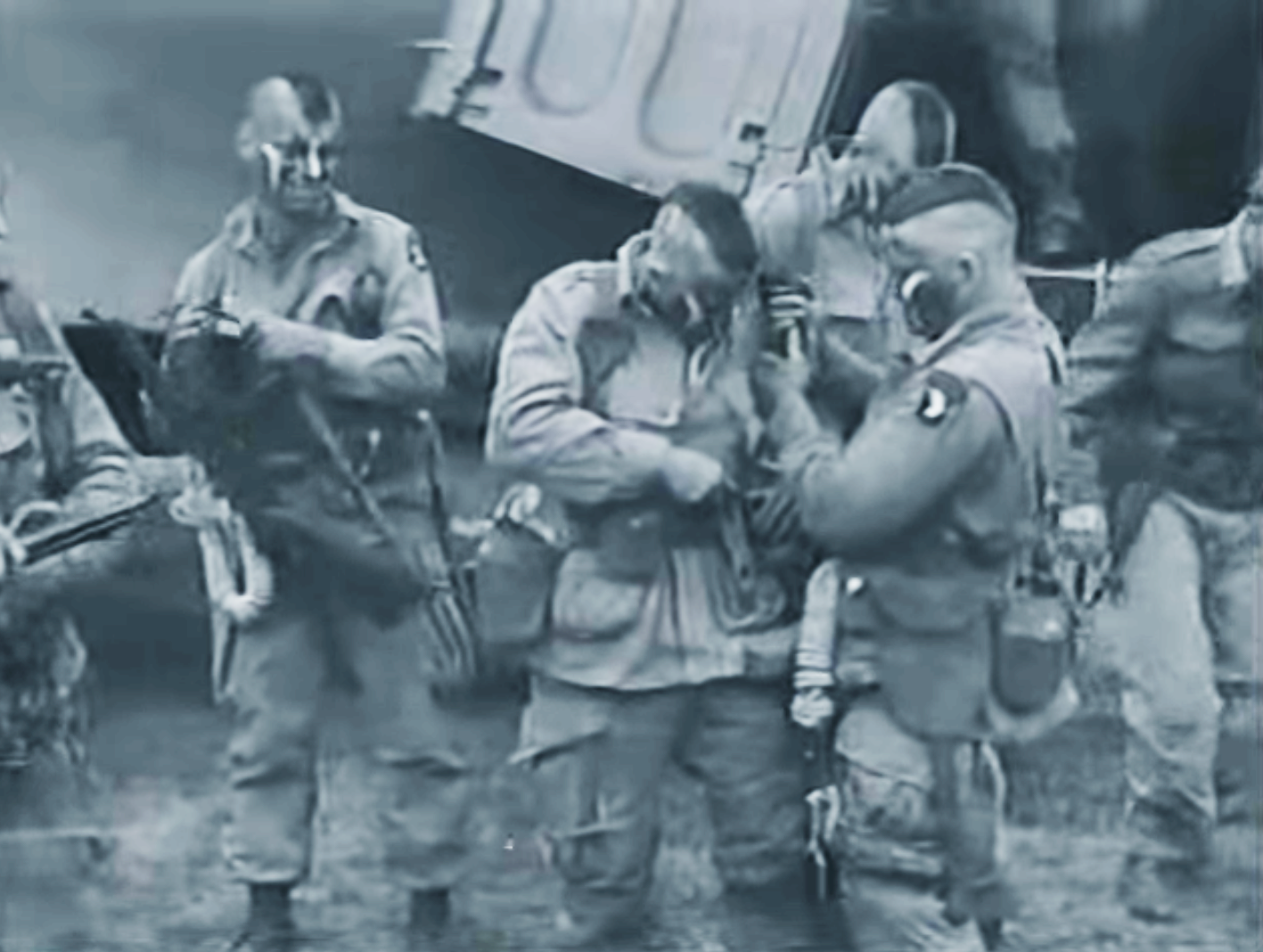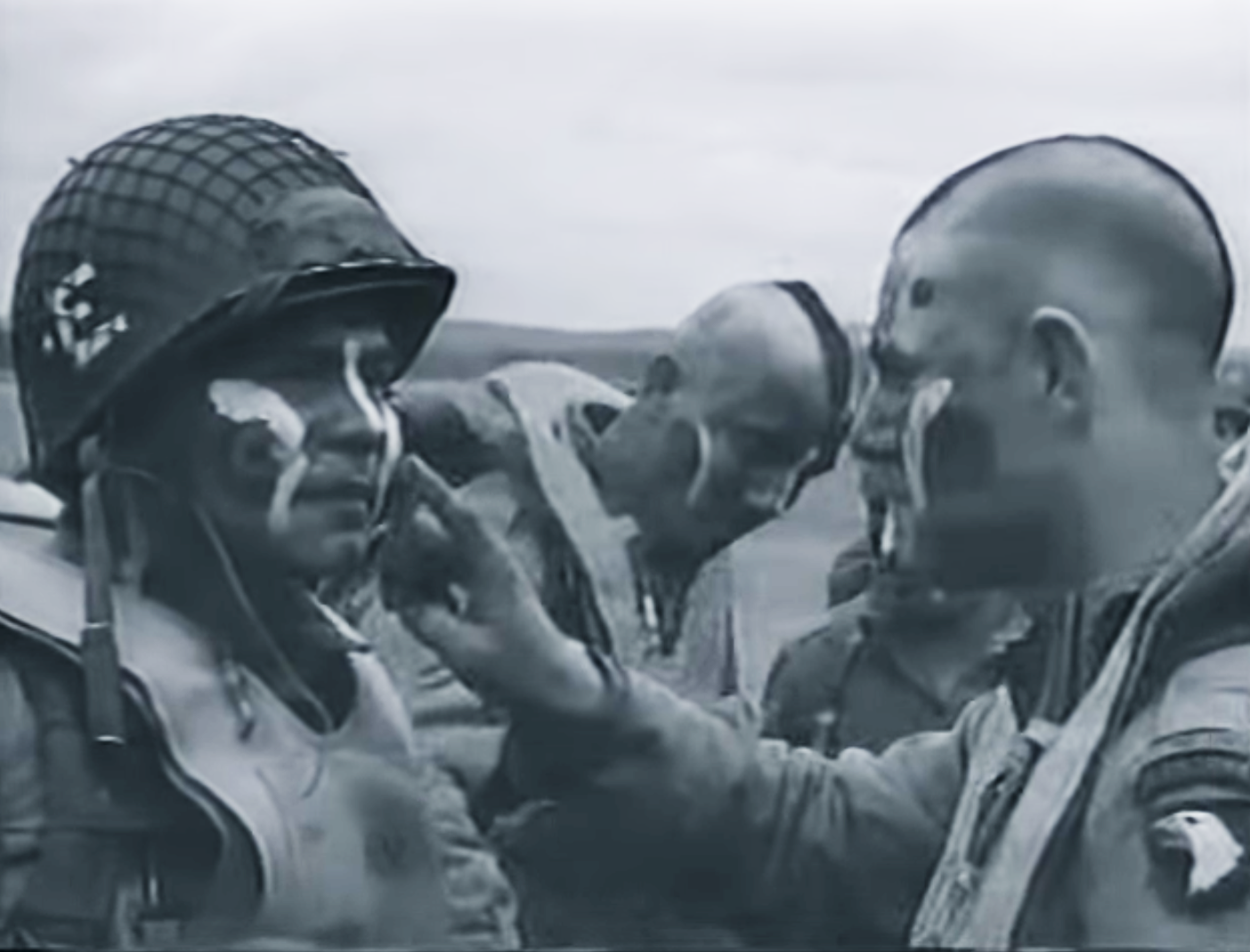This is the fifth and final post of the Filthy Thirteen five-part series. For a synopsis of these colorful characters, creating the figures in 1/72 scale, selecting their weapons, and a look at the finished figures, please refer to the previous four posts, The Filthy Thirteen, Part 1, Part 2, Part 3, and Part 4, respectively.
The Group Photo
As previously mentioned, our 1/72 scale Filthy Thirteen are bareheaded — clearly not in combat as they’re not wearing a helmet. Thus, one of the few plausible diorama options was a scene taking place just prior to boarding the aircraft. Before embarking on a mission, it was customary for a stick of paratroopers to pose for a group photo with the pilot and crew of the aircraft. (A paratrooper stick typically numbered 15-18 men.) The reader is directed to the History Channel’s Dangerous Missions: Pathfinders episode, for example, wherein a paratrooper recalls sitting for the group photo. “They must be taking a photo for our obituary,” he quips wryly. The photo below, for example, is of the 506th Parachute Infantry Regiment just before boarding for a mission. 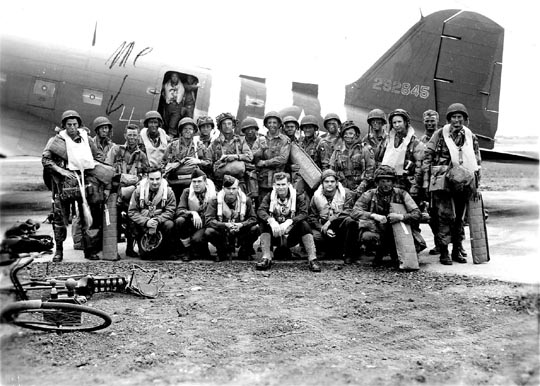 The Diorama
The Diorama
The diorama below depicting such a photo shoot at Upottery Airfield in East Devon, England, just before the Filthy Thirteen board their aircraft, is loosely based on this concept. A kneeling paratrooper, a sergeant, and a pilot stand directly facing the photographer, with the rest of the stick arranged in a semicircle in front of a Douglas C-47 Skytrain. A brief discussion and additional photos of the Skytrain appear in a separate section below.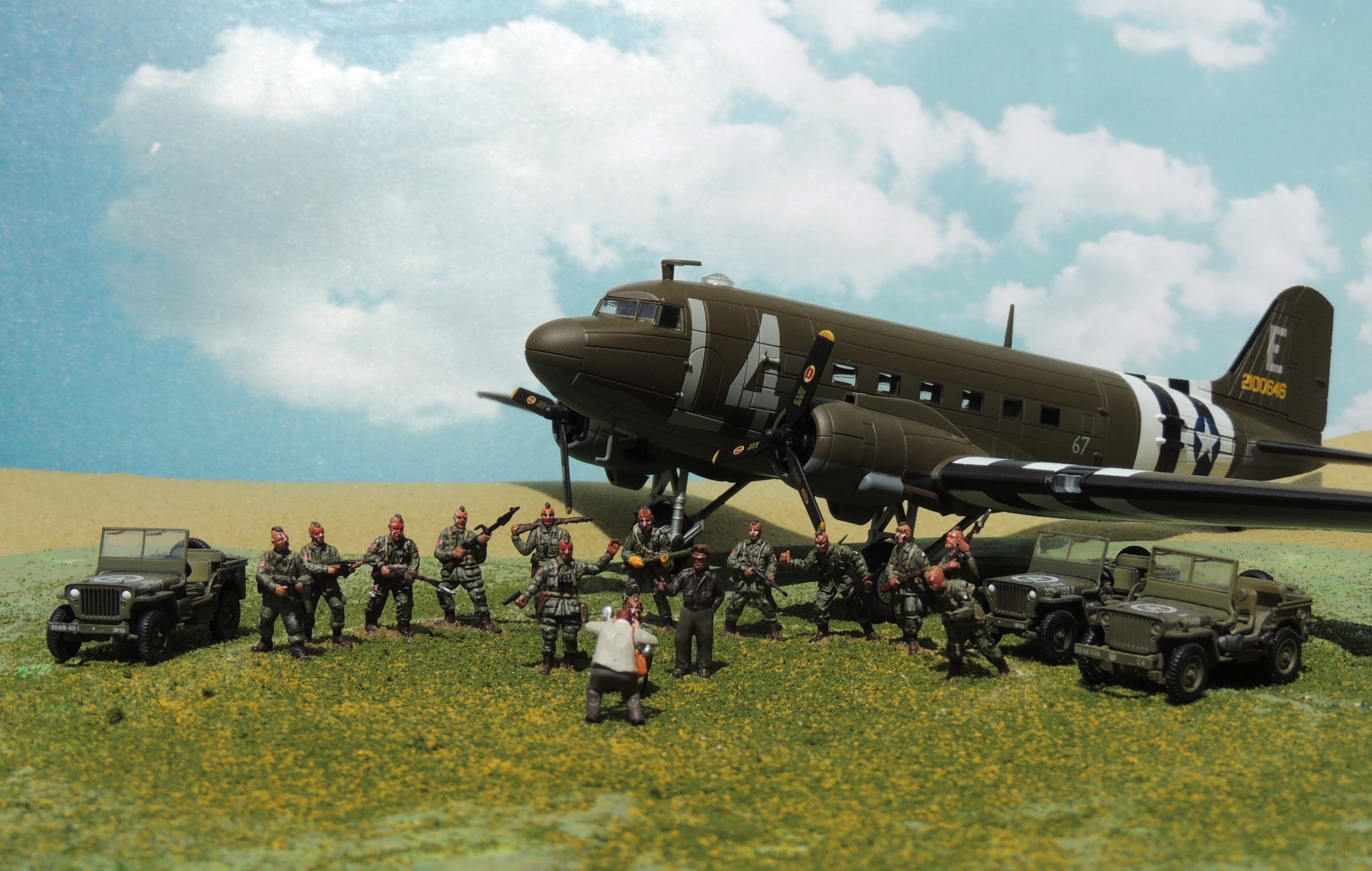 Below is a close-up photo of the scene. The paratroopers have been discussed extensively in previous posts so I will not belabor them further. However, I point the reader’s attention to the pilot, who is also covered in a separate section below.
Below is a close-up photo of the scene. The paratroopers have been discussed extensively in previous posts so I will not belabor them further. However, I point the reader’s attention to the pilot, who is also covered in a separate section below. Below is a view from the right side. I was unable to locate a 1/72 scale U.S. photographer so I ended up using a Preiser HO scale figure. Note the three Jeeps, which were ubiquitous at Upottery Airfield.
Below is a view from the right side. I was unable to locate a 1/72 scale U.S. photographer so I ended up using a Preiser HO scale figure. Note the three Jeeps, which were ubiquitous at Upottery Airfield.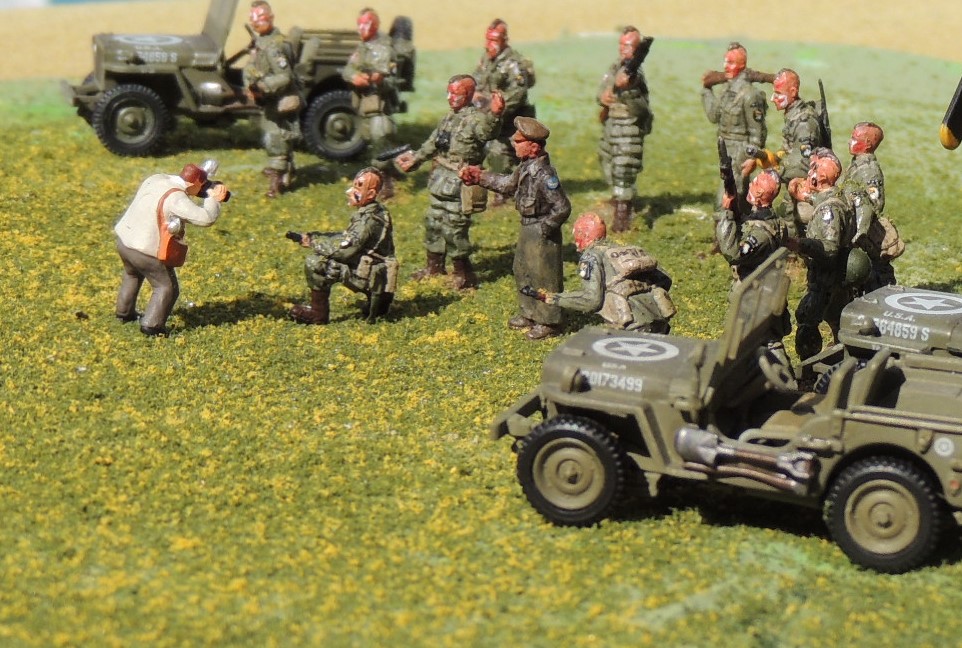 Below is a view from the left side. Note the markings on the front bumper of the Willys Jeep on the right, which clearly identify it as belonging to the 506th Parachute Infantry Regiment. (Click on the photo to zoom in on the bumper.)
Below is a view from the left side. Note the markings on the front bumper of the Willys Jeep on the right, which clearly identify it as belonging to the 506th Parachute Infantry Regiment. (Click on the photo to zoom in on the bumper.)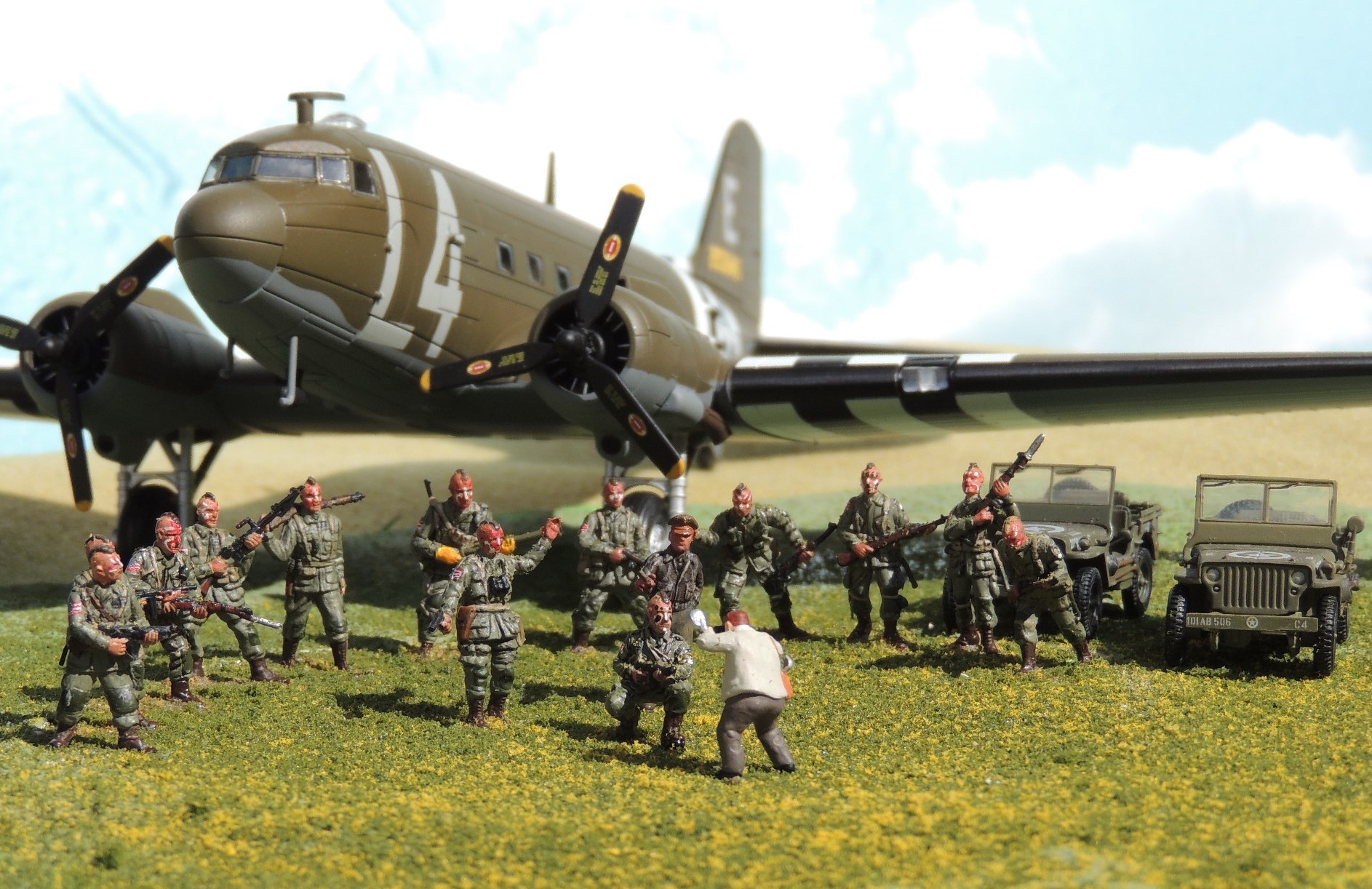 Below is an overhead shot. Note the drybrushing on the pilot’s leather jacket, which came out better than I expected, once again proving the adage, particularly applicable to me, that “even a stopped clock is right twice a day.”
Below is an overhead shot. Note the drybrushing on the pilot’s leather jacket, which came out better than I expected, once again proving the adage, particularly applicable to me, that “even a stopped clock is right twice a day.” 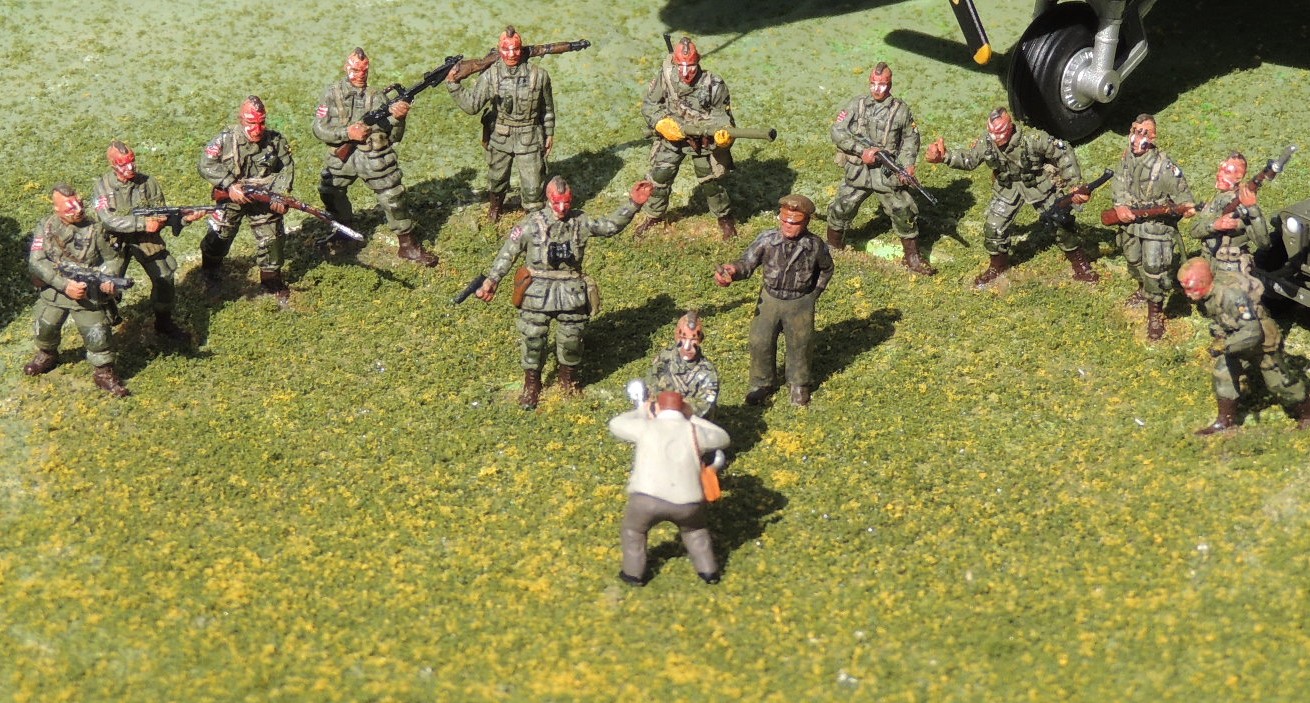 For those skeptical that paratroopers would actually pose for photos, I direct you to the photo below of Jake McNiece, taken just before the Filthy Thirteen boarded their C-47 on D-Day.
For those skeptical that paratroopers would actually pose for photos, I direct you to the photo below of Jake McNiece, taken just before the Filthy Thirteen boarded their C-47 on D-Day.
The Pilot
Given that group photos often included the aircraft crew, the scene cried out for a pilot. As shown in the composite photo below, there are several U.S. pilot options in 1/72 scale.

While I considered the pilots from the Airfix 1748 U.S.A.F. Personnel, CMK 72039 US Army Pilots (resin), CMK 72221 USAAF Pilots (resin), and Hasegawa 35008 WWII Pilots sets, I ultimately opted for the pilot included in the white metal TQD-AA9 US Airborne Infantry & Pilot set, as I found it to have the quintessential WWII U.S. pilot “look.”
The TQD pilot sports the A-2 leather flying jacket so characteristic of WWII U.S. pilots. 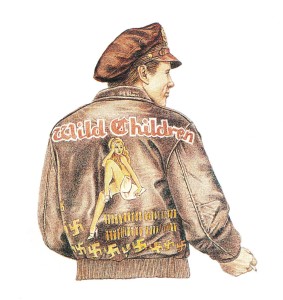 The backs of these brown leather jackets were often decorated with squadron insignia, victory slogans, or pinup art, as seen in the illustration at left by Francis Chin taken from Osprey Publishing US Army Air Force. The TQD figure also wears the popular officer’s peaked cap that was often worn with the crown stiffener removed, both to get the stylish “crushed” look and, more importantly, to allow the headset to fit over the cap. Note also that these pilots are almost invariably depicted either smoking a cigarette, as in the illustration, or chomping on a cigar, as in the TQD figure. I rejected the Airfix and CMK figures because they appear to be wearing the winter B-3 jacket with fur collar. I note, however, that CMK resin figures are generally some of the most realistic 1/72 scale figures on the market. Similarly, I passed over the Hasegawa figure because it’s wearing the garrison side cap with earflaps, rather than the more distinctive peaked cap.
The backs of these brown leather jackets were often decorated with squadron insignia, victory slogans, or pinup art, as seen in the illustration at left by Francis Chin taken from Osprey Publishing US Army Air Force. The TQD figure also wears the popular officer’s peaked cap that was often worn with the crown stiffener removed, both to get the stylish “crushed” look and, more importantly, to allow the headset to fit over the cap. Note also that these pilots are almost invariably depicted either smoking a cigarette, as in the illustration, or chomping on a cigar, as in the TQD figure. I rejected the Airfix and CMK figures because they appear to be wearing the winter B-3 jacket with fur collar. I note, however, that CMK resin figures are generally some of the most realistic 1/72 scale figures on the market. Similarly, I passed over the Hasegawa figure because it’s wearing the garrison side cap with earflaps, rather than the more distinctive peaked cap.
The Willys Jeep
Numerous sources of information on the jeep are readily available and the reader is directed to them. However, for the sake of completeness, below are several photos of the jeeps used in the diorama. To my knowledge, there are only two 1/72 scale jeeps that specifically represent the 101st Airborne Division. First, below is the Hobby Master HG4203, US Willys Jeep, 101st Airborne Div., 506th A.B. Regiment, Company “C,” Normandy, 6 June 1944 (2010).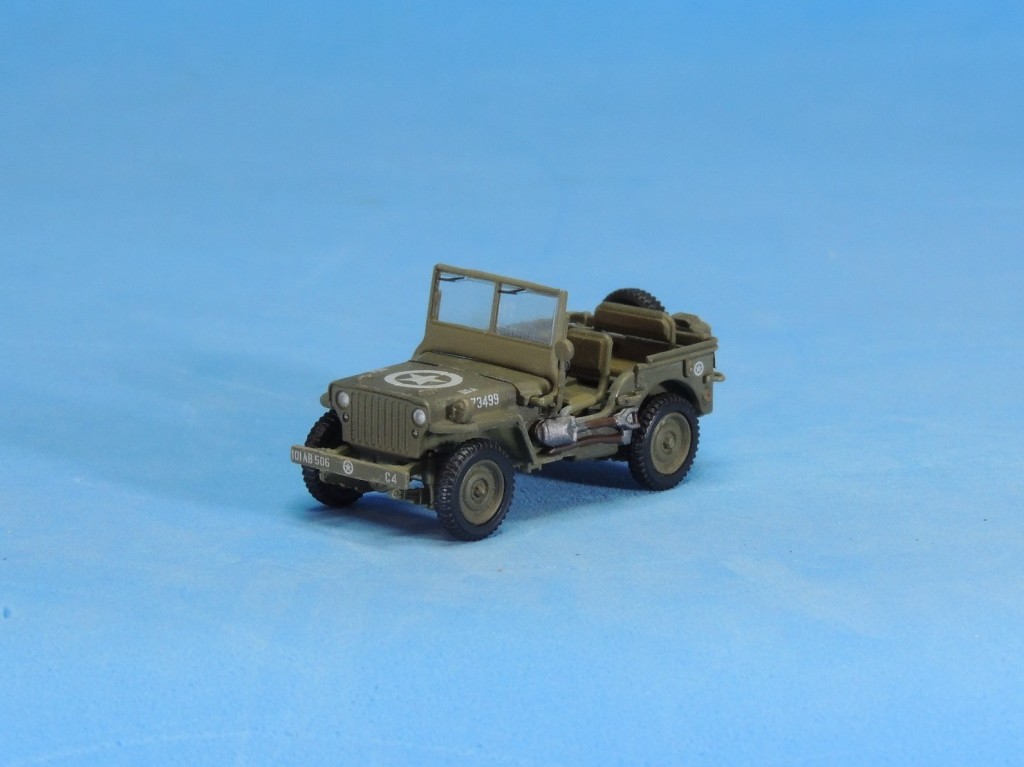 Made of diecast, the Hobby Master’s heft is pleasing to the hand. Below is a portside view.
Made of diecast, the Hobby Master’s heft is pleasing to the hand. Below is a portside view.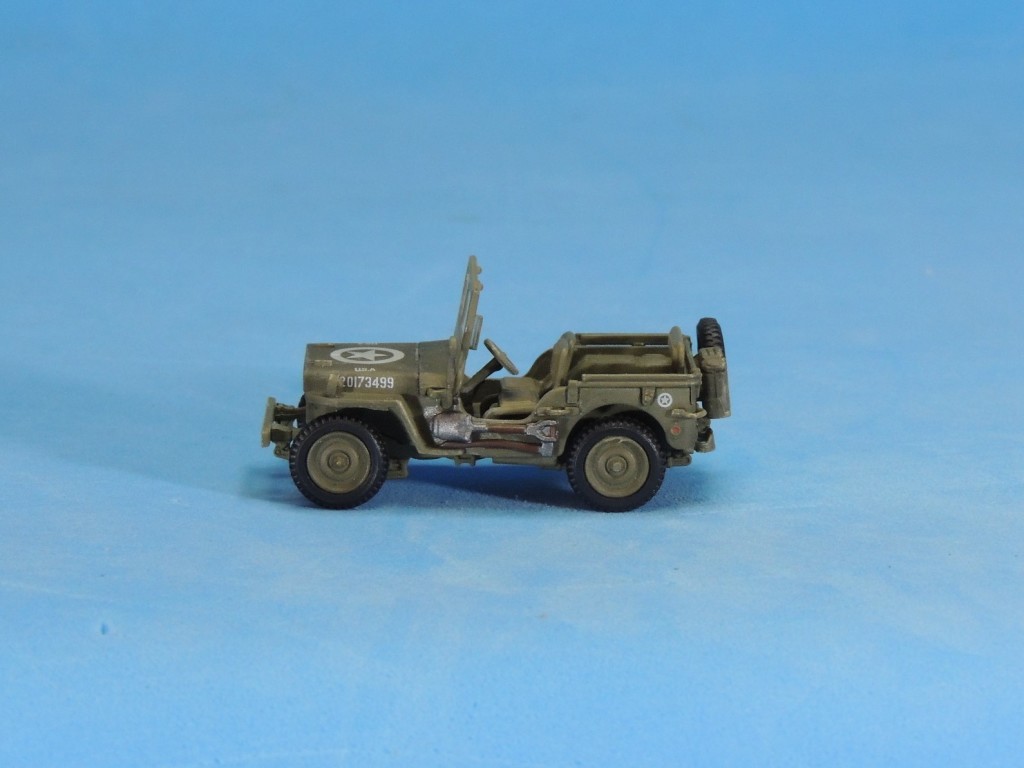 Below is a front view shot of the Hobby Master model. The markings of the 101st Airborne Division 506th Parachute Infantry Regiment are clearly visible on the bumper.
Below is a front view shot of the Hobby Master model. The markings of the 101st Airborne Division 506th Parachute Infantry Regiment are clearly visible on the bumper.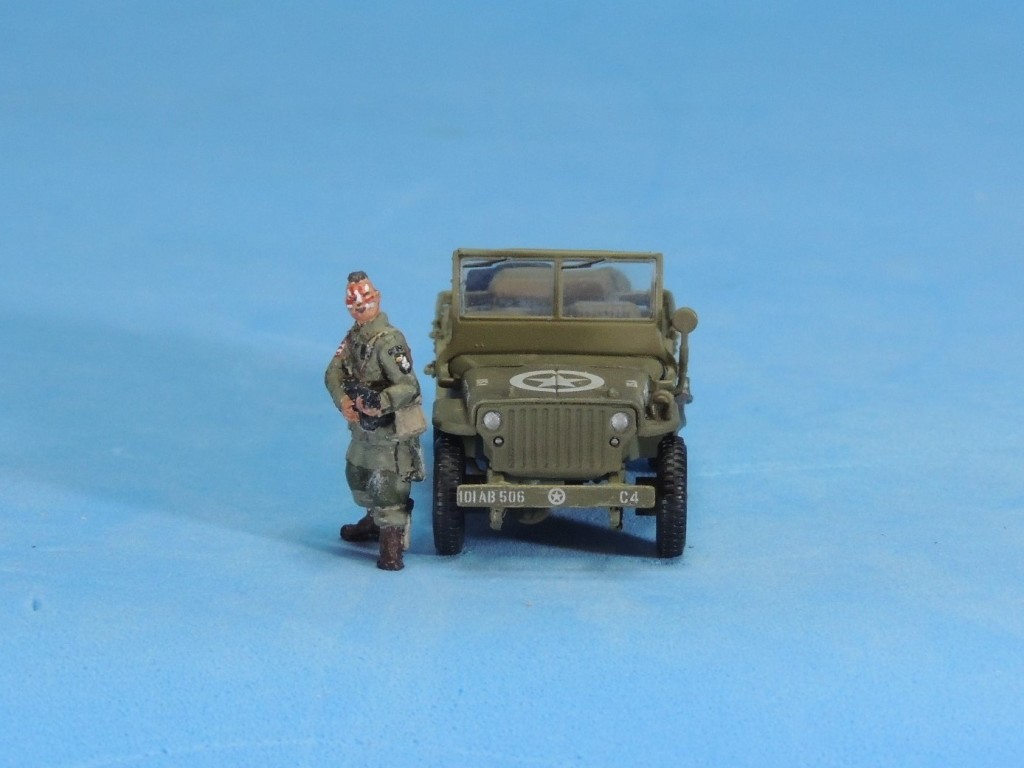 Pictured below is the only other 1/72 scale jeep specifically representing the 101st Infantry Division, the Dragon 60505, 1/4 Ton 4×4 Truck, U.S. Army Western Front 1944, 101st Airborne Division, 401st Glider Infantry Regiment, France 1944 (2011).
Pictured below is the only other 1/72 scale jeep specifically representing the 101st Infantry Division, the Dragon 60505, 1/4 Ton 4×4 Truck, U.S. Army Western Front 1944, 101st Airborne Division, 401st Glider Infantry Regiment, France 1944 (2011). 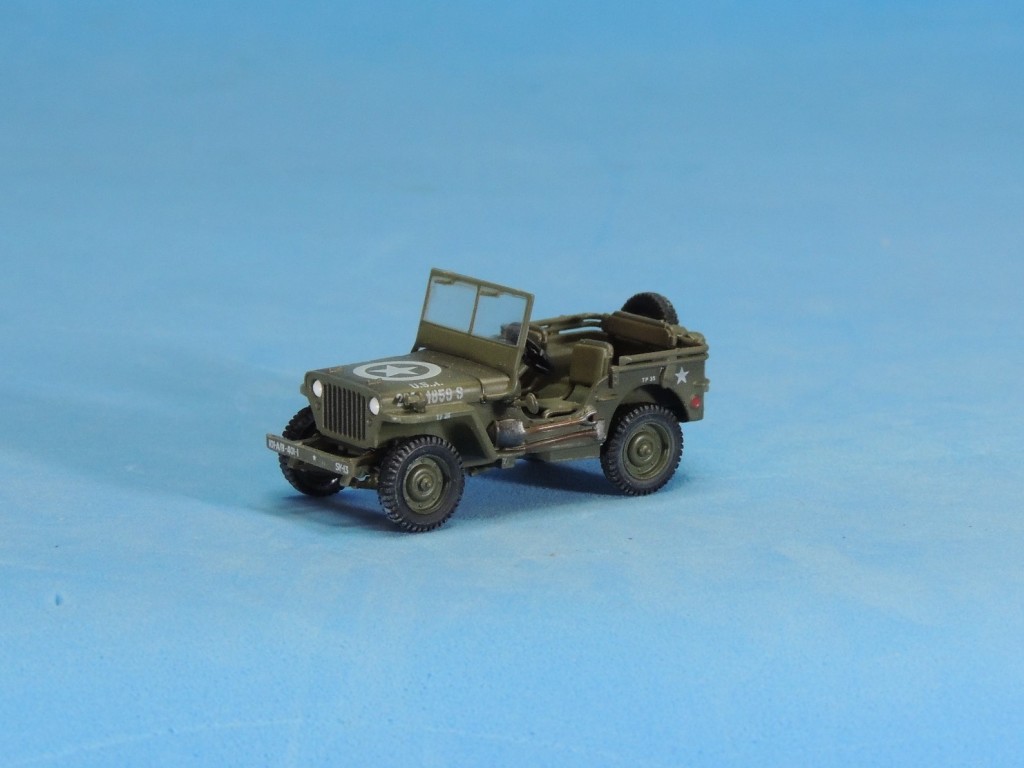 Unlike the Hobby Master, the Dragon 60505 is all plastic and, like other Dragon jeep releases, comes bundled in a package of two. Below is a portside view.
Unlike the Hobby Master, the Dragon 60505 is all plastic and, like other Dragon jeep releases, comes bundled in a package of two. Below is a portside view.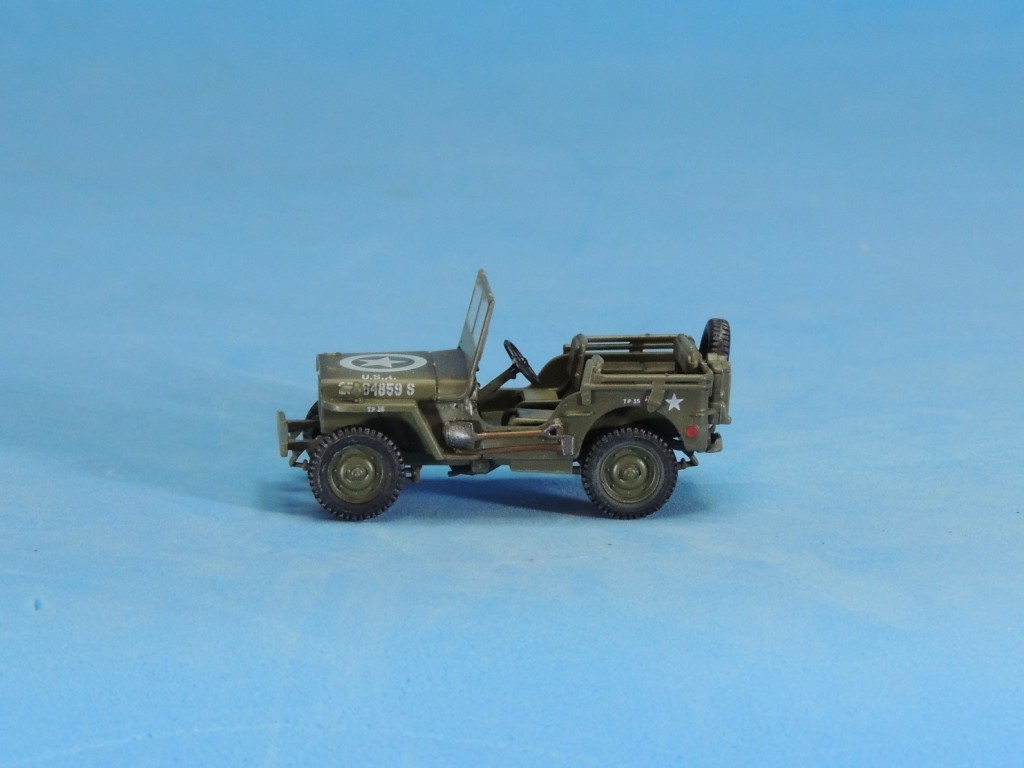 Finally, below is a side-by-side photo of the Hobby Master and Dragon pieces. As is readily apparent from the photo, the Hobby Master (left) is slightly larger than the Dragon (right). I note that the proportions of the Hobby Master are identical to those of the Cararama and Zylmex 1/72 scale jeeps and it’s probably at scale. In addition, there are reports that the Dragon jeep is underscaled — probably at 1/76 scale. While the Hobby Master model is diecast and the Dragon piece is plastic, a quick glance at the radiator grilles in the photo below immediately attests to Dragon’s redeeming quality — realism.
Finally, below is a side-by-side photo of the Hobby Master and Dragon pieces. As is readily apparent from the photo, the Hobby Master (left) is slightly larger than the Dragon (right). I note that the proportions of the Hobby Master are identical to those of the Cararama and Zylmex 1/72 scale jeeps and it’s probably at scale. In addition, there are reports that the Dragon jeep is underscaled — probably at 1/76 scale. While the Hobby Master model is diecast and the Dragon piece is plastic, a quick glance at the radiator grilles in the photo below immediately attests to Dragon’s redeeming quality — realism.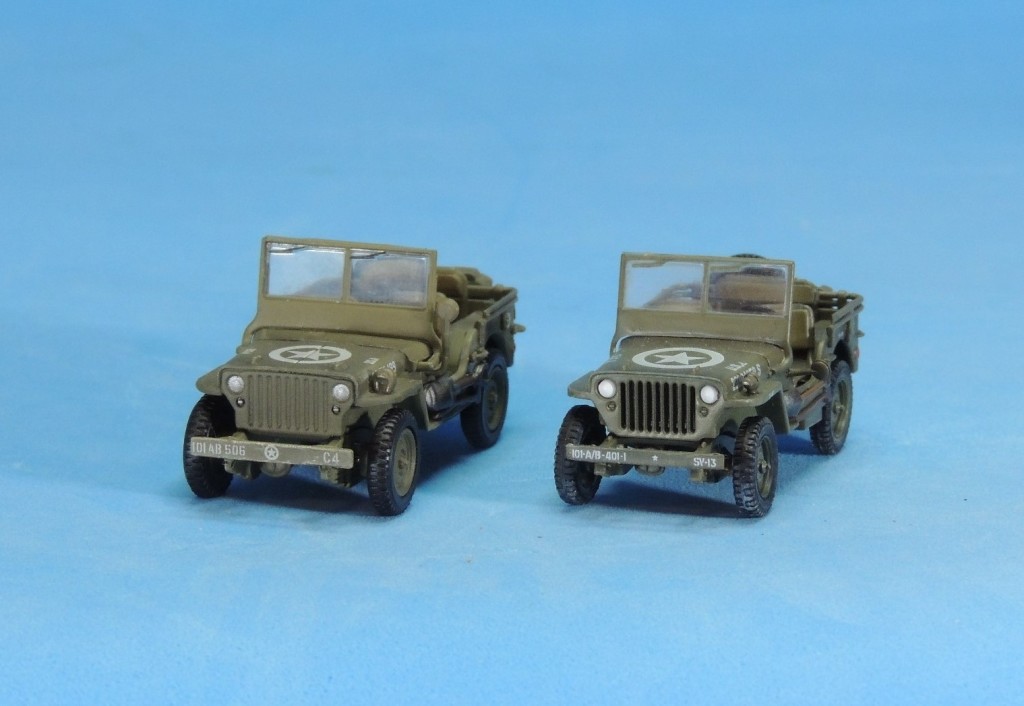 The C-47 Skytrain
The C-47 Skytrain
The first thing one notices in the diorama is the fabulous Douglass C-47 Skytrain behind the paratroopers. While the versatile “Gooney Bird,” as the Skytrain was known to Air Force personnel, had various military uses, its primary role was as a transport plane, ferrying paratroopers to its targets and becoming the most widely used transport of World War II. Douglas built 10,700 C-47s and more than 1,000 of these participated in the D-Day invasion alone. Below is a portside view of the diecast Corgi AA38207 used in the diorama.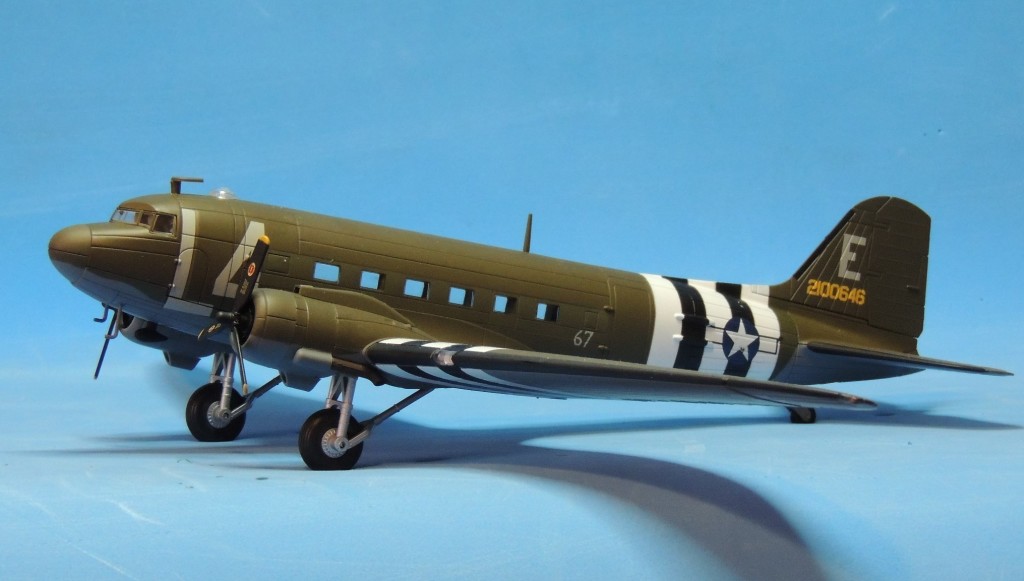 Band of Brothers, the highly acclaimed TV Mini-Series (2001) depicting the travails of the 506th Parachute Infantry Regiment of the 101st Airborne Division, brought international fame to the 506th PIR and spawned a number of products specifically depicting that unit. The Corgi AA38207, for example, represents the transport for Richard “Dick” Winters, the leader of the first platoon of the 2nd Battalion, 506th PIR of the 101st AD. Below is a starboard shot.
Band of Brothers, the highly acclaimed TV Mini-Series (2001) depicting the travails of the 506th Parachute Infantry Regiment of the 101st Airborne Division, brought international fame to the 506th PIR and spawned a number of products specifically depicting that unit. The Corgi AA38207, for example, represents the transport for Richard “Dick” Winters, the leader of the first platoon of the 2nd Battalion, 506th PIR of the 101st AD. Below is a starboard shot.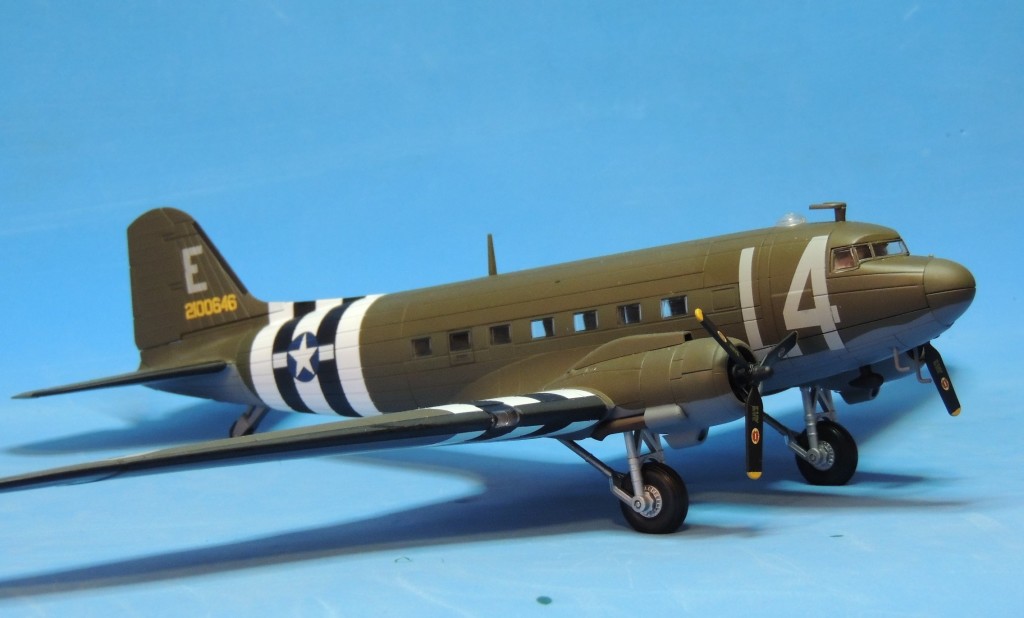 Below is a shot taken from the front. The 95 ft. 6 in. wingspan of the Douglass C-47 Skytrain was virtually identical to its German counterpart, the Junkers Ju52 “Tante Ju,” which had a wingspan of 95 ft. 11 in. Note the realistic transparent lens of the landing lights on the leading edge of the wings.
Below is a shot taken from the front. The 95 ft. 6 in. wingspan of the Douglass C-47 Skytrain was virtually identical to its German counterpart, the Junkers Ju52 “Tante Ju,” which had a wingspan of 95 ft. 11 in. Note the realistic transparent lens of the landing lights on the leading edge of the wings.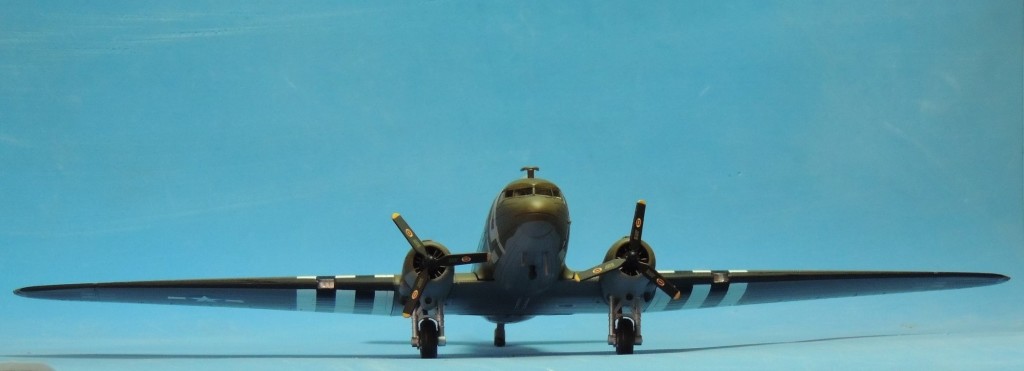 As can be readily appreciated in the photo below, the Corgi AA38207 is a magnificent piece of diecast. It’s unfortunate that the model disappeared from the shelves long ago. Note the pilot and co-pilot figures through the windows.
As can be readily appreciated in the photo below, the Corgi AA38207 is a magnificent piece of diecast. It’s unfortunate that the model disappeared from the shelves long ago. Note the pilot and co-pilot figures through the windows.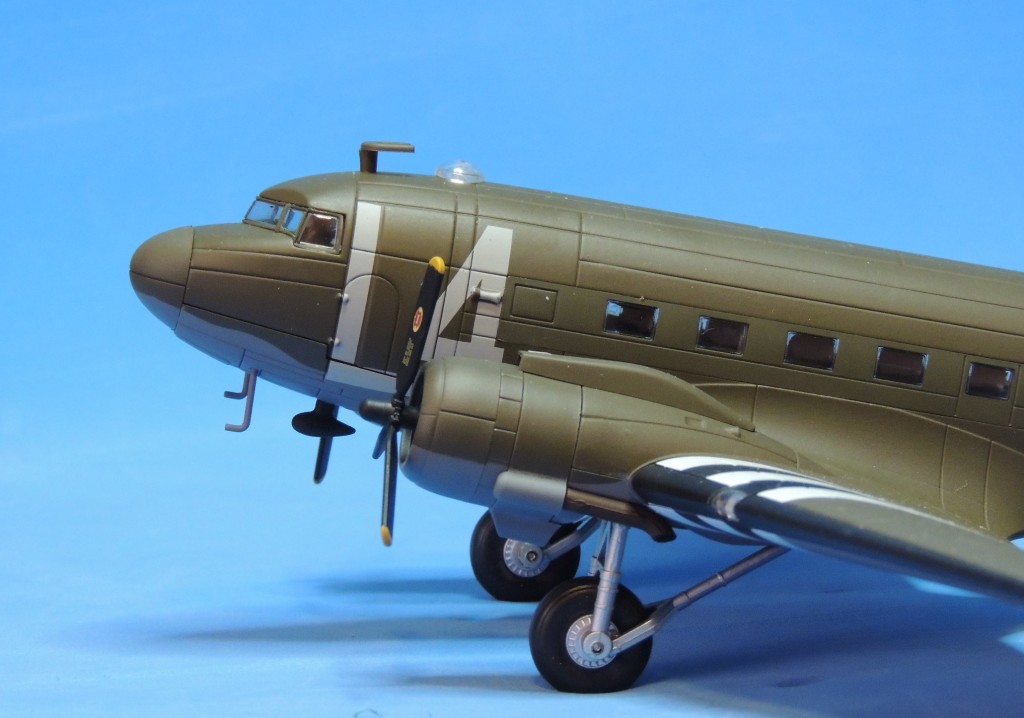 Below is shot of the portside fuselage. I almost wish Corgi had designed the model with an opening cargo door but such features often come at the expense of accuracy, making the models look toyish. Still, an opening cargo door would provide additional diorama opportunities.
Below is shot of the portside fuselage. I almost wish Corgi had designed the model with an opening cargo door but such features often come at the expense of accuracy, making the models look toyish. Still, an opening cargo door would provide additional diorama opportunities.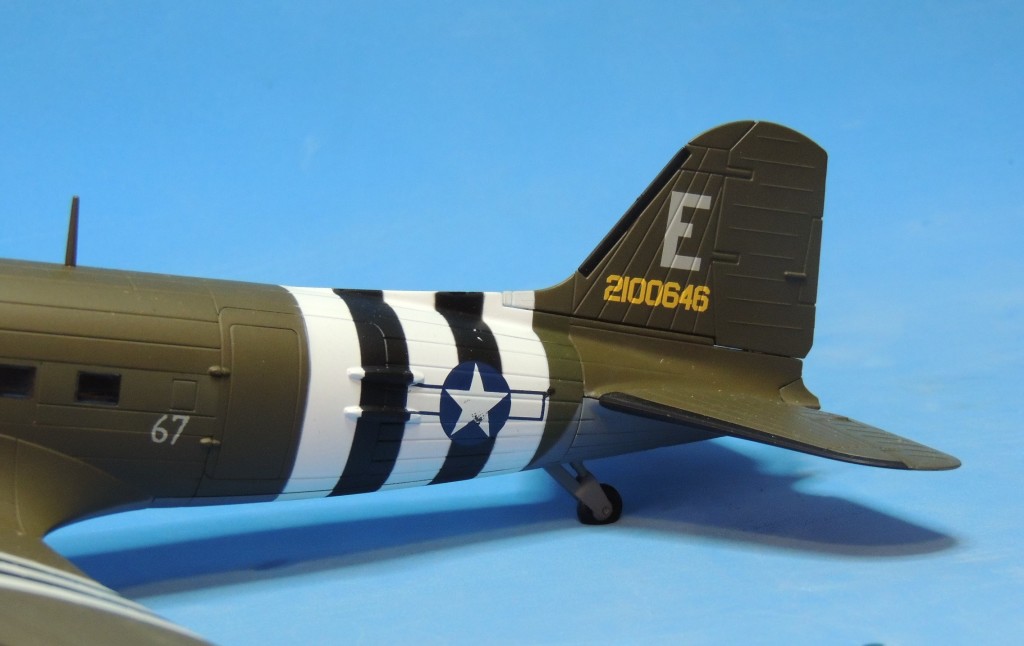 The Terrain
The Terrain
Because of their small size, creating realistic braille scale dioramas is inherently challenging — at least for a novice like me. In addition, the bases of the figures significantly detract from any setting, no matter how realistic it is. Thus, I had two options to try to improve the diorama: Either clip the bases of the figures as I have done for previous posts, or find a way to hide them. I opted for the latter.
I began by cutting out the flat part of styrofoam paper plate. I proceeded to draw the outline of the bases of the figures on the plate and carefully carved them out. When I inserted the figures into the recessed slots in the flat base, I found to my surprise that they fit snugly and were neatly flush with the base. The photo below shows the figures already embedded in the base. (Click on the photo to zoom in on the base.)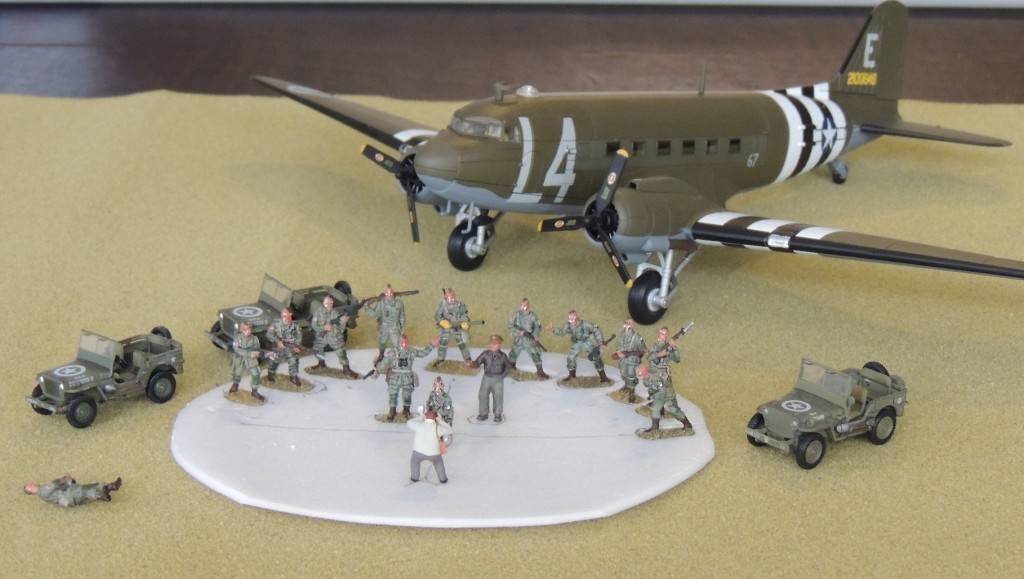 I then enlarged the base with additional styrofoam plates, covered it with hydrocal plaster to create contoured terrain, and painted it with acrylic paints. Finally, I flocked it with Woodland Scenics green and yellow grass to resemble Upottery Airfield in East Devon, England, whence the flights for D-Day originated. The photo below shows the countours of the terrain.
I then enlarged the base with additional styrofoam plates, covered it with hydrocal plaster to create contoured terrain, and painted it with acrylic paints. Finally, I flocked it with Woodland Scenics green and yellow grass to resemble Upottery Airfield in East Devon, England, whence the flights for D-Day originated. The photo below shows the countours of the terrain.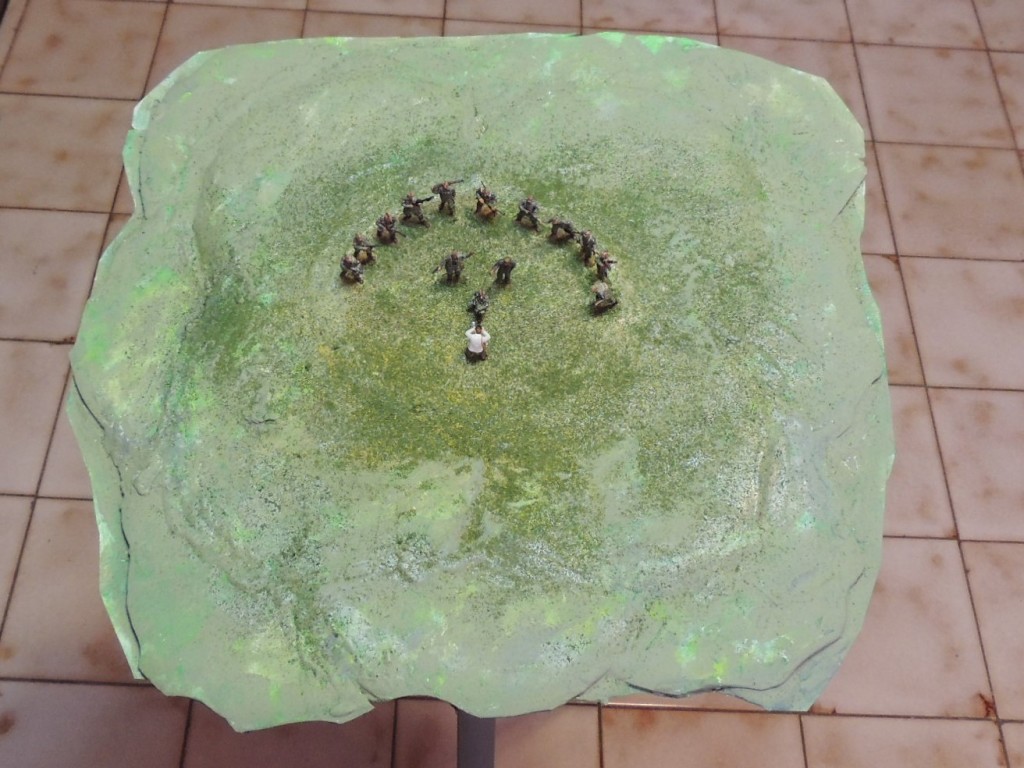 The Meltdown
The Meltdown
While taking photos of the diorama in my backyard, I realized that the sky backdrop had warped, completely ruining the photos — and an entire morning. 
Despite diligent efforts and newly acquired photographic lights, indoor illumination continues to confound me, resulting in my strong preference for outdoor photography with natural light. Thus, after ensuring that there was no warping and the glue had set, I again moved the pieces outside and began to photograph. Alas, within ten minutes, the poster began to warp again. I suddenly realized that the 90 degree heat outdoors was melting the glue. As with the warped deck of an aircraft carrier in a previous project, I was once again paying the price of my incompetence and inability to take adequate photos indoors. Nonetheless, the few photos I managed to take before the meltdown were sufficient for this post. The side-by-side photo below is worth a thousand words.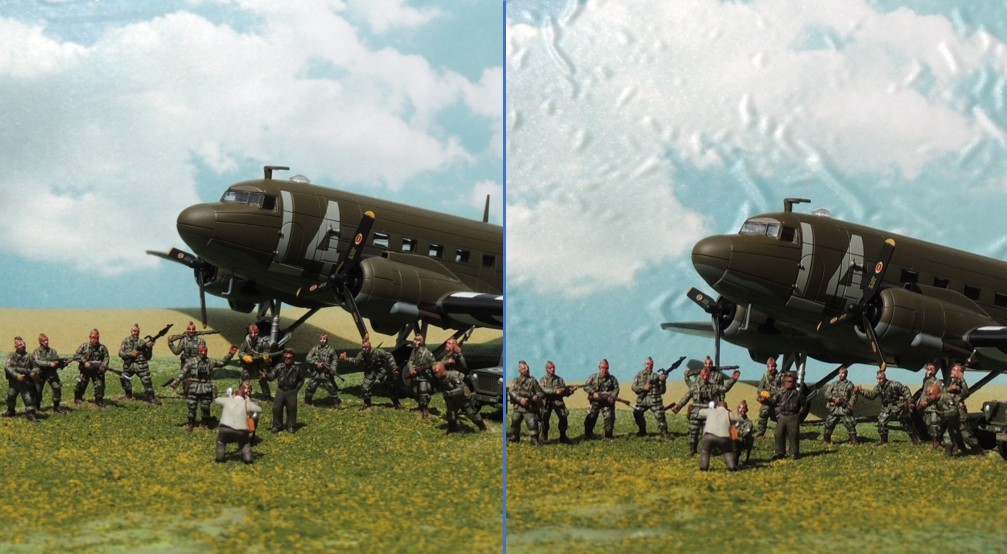
List of Diorama Pieces
For those interested, below is the source of each piece:
- Photographer: Preiser 28069, Photographer (HO Scale);
- Pilot: TQD Castings, TQD-AA9, US Airborne Infantry & Pilot Boarding Aircraft;
- Paratroopers: Various sets (see previous four posts);
- Jeep (far right): Hobby Master HG4203, US Willys Jeep, 101st Airborne Div., 506th A.B. Regiment, Company “C,” Normandy, 6 June 1944 (2010);
- Other Jeeps: Dragon 60505, 1/4 Ton 4×4 Truck, U.S. Army Western Front 1944, 101st Airborne Div., 401st Glider Infantry Rgt., France 1944 (2011);
- Aircraft: Corgi AA38207, Douglas C-47 Skytrain, USAAF 439th TCG, 50th TCW, June 5th, Upottery, England (2014);
- Meadow: Styrofoam plates painted with acrylic colors and flocked with Woodland Scenics grasses;
- Backdrop: Silk poster ordered on Amazon from China.
Lagniappe
This series of posts began with a wonderful painting of the Filthy Thirteen by Joel Iskowitz. It is only fitting, therefore, that it end with another beautiful painting. The lagniappe painting below, entitled We Were a Band of Brothers, is by John D. Shaw. It is reproduced here for discussion purposes under the fair use exception to the copyright laws. 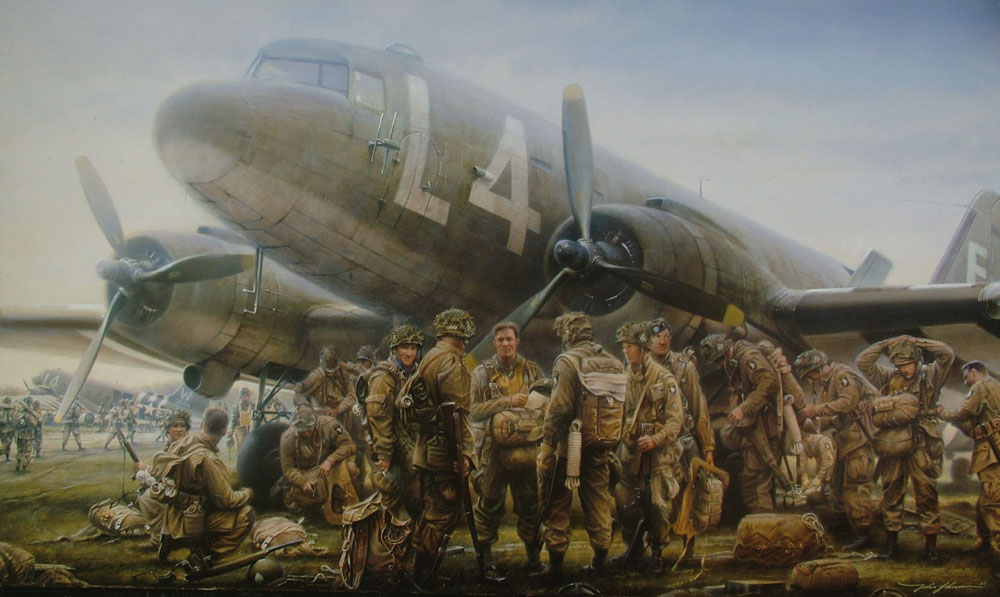 I hope you enjoyed this simple diorama and the Filthy Thirteen series of posts. Again, if something looks amiss, please let me know. I would be delighted to correct inaccurate information so that this may be useful for other 1/72 scale collectors and wargamers. As always, comments, questions, corrections, and observations are welcome.
I hope you enjoyed this simple diorama and the Filthy Thirteen series of posts. Again, if something looks amiss, please let me know. I would be delighted to correct inaccurate information so that this may be useful for other 1/72 scale collectors and wargamers. As always, comments, questions, corrections, and observations are welcome.



 )
)